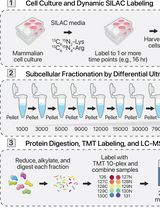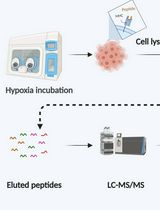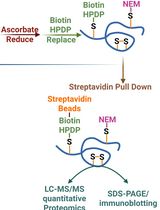- EN - English
- CN - 中文
In vitro AMPylation/Adenylylation of Alpha-synuclein by HYPE/FICD
HYPE/FICD法体外氨酰化/腺苷酰化α-突触核蛋白
发布: 2020年09月20日第10卷第18期 DOI: 10.21769/BioProtoc.3760 浏览次数: 4303
评审: David PaulDeepali BhandariAnonymous reviewer(s)
Abstract
One of the major histopathological hallmarks of Parkinson’s disease are Lewy bodies (LBs) –cytoplasmic inclusions, enriched with fibrillar forms of the presynaptic protein alpha-synuclein (α-syn). Progressive deposition of α-syn into LBs is enabled by its propensity to fibrillize into insoluble aggregates. We recently described a marked reduction in α-syn fibrillation in vitro upon posttranslational modification (PTM) by the Fic (Filamentation induced by cAMP) family adenylyltransferase HYPE/FICD (Huntingtin yeast-interacting protein E/FICD). Specifically, HYPE utilizes ATP to covalently decorate key threonine residues in α-syn’s N-terminal and NAC (non-amyloid-β component) regions with AMP (adenosine monophosphate), in a PTM termed AMPylation or adenylylation. Status quo in vitro AMPylation reactions of HYPE substrates, such as α-syn, use a variety of ATP analogs, including radiolabeled α-32P-ATP or α-33P-ATP, fluorescent ATP analogs, biotinylated-ATP analogs (N6-[6-hexamethyl]-ATP-Biotin), as well as click-chemistry-based alkyl-ATP methods for gel-based detection of AMPylation. Current literature describing a step-by-step protocol of HYPE-mediated AMPylation relies on an α-33P-ATP nucleotide instead of the more commonly available α-32P-ATP. Though effective, this former procedure requires a lengthy and hazardous DMSO-PPO (dimethyl sulfoxide-polyphenyloxazole) precipitation. Thus, we provide a streamlined alternative to the α-33P-ATP-based method, which obviates the DMSO-PPO precipitation step. Described here is a detailed procedure for HYPE mediated AMPylation of α-syn using α-32P-ATP as a nucleotide source. Moreover, our use of a reusable Phosphor screen for AMPylation detection, in lieu of the standard, single-use autoradiography film, provides a faster, more sensitive and cost-effective alternative.
Keywords: AMPylation (氨酰化)Background
Deposition of the small (140 amino acids), intrinsically disordered protein alpha-synuclein (α-syn) into Lewy bodies (LBs) is a major hallmark of Parkinson’s disease (PD) (Weinreb et al., 1996; Spillantini et al., 1997). On its way to forming the insoluble aggregates found in LBs, monomeric α-syn adopts a β-sheet-rich, amyloid-like conformation, leading to progressive fibrillation and concomitant insolubility (Iwai et al., 1995). Multiple lines of research describe a compelling correlation between post-translational modifications (PTMs) of α-syn and its oligomeric state. Phosphorylation at Ser 129, for example, is prevalent on aggregated α-syn found within LBs (Chen and Feany, 2005). Tyrosine nitrations of α-syn have been linked to formation of stable oligomers and reduced fibril formation (Yamin et al., 2003), while O-GlcNAcylation of threonine residues reduces α-syn aggregation (Levine et al., 2019). Recently, we described a novel α-syn modification–adenylylation or AMPylation–which reduces α-syn fibrillation in vitro (Sanyal et al., 2019). Moreover, AMPylated α-syn displayed diminished disease-linked phenotypes, such as membrane permeabilization (Ysselstein et al., 2017; Sanyal et al., 2019).
We demonstrated that HYPE, the sole Fic protein in humans, carried out AMPylation of α-syn (Worby et al., 2009; Sanyal et al., 2019). Like other members of the conserved Fic domain protein family, HYPE’s AMPylation activity is intrinsically regulated by an inhibitory helix called αinh (Engel et al., 2012). Mutation of HYPE’s conserved Glu234 to Gly within the αinh renders HYPE constitutively active for its adenylyltransferase activity (Engel et al., 2012; Sanyal et al., 2015). HYPE then covalently attaches the AMP portion of an ATP co-substrate onto target hydroxyl side-chain residues (e.g., serine or threonine) (Ham et al., 2014; Sanyal et al., 2015; Truttmann et al., 2016; Preissler et al., 2017). Indeed, tandem mass spectrometric analysis of purified, recombinant α-syn mapped AMPylation sites to three threonines–T33, T54, and T75–located within regions hypothesized to be crucial for oligomerization (Sanyal et al., 2019).
Several biochemical assays monitoring Fic-mediated AMPylation have been reported (Worby et al., 2009; Mattoo et al., 2011; Yarbrough et al., 2009; Lewallen et al., 2012; Truttmann et al., 2016; Dedic et al., 2016). Most common amongst these are assays using a fluorescent (Fl-ATP) or radioactive (α-32P-ATP or α-33P-ATP) ATP analogs. While Fl-ATP has served as a useful research tool, its large, bulky fluorescent moiety is known to stunt kinetic efficiencies (Lewallen et al., 2012). Moreover, no step-by-step protocol for Fl-ATP AMPylation has been documented. A detailed procedure for α-33P-ATP, however, is available (Truttmann and Ploegh, 2017). This method entails incubation of HYPE and its protein target with radiolabelled α-33P-ATP, followed by separation via SDS-PAGE, DMSO-PPO precipitation, and then imaging of radiolabeled proteins on autoradiography film. Though effective in detecting AMPylation, this procedure suffers from additional time-consuming steps that are expensive and require hazardous chemicals (e.g., DMSO-PPO and autoradiography exposure and development). Herein, we present an optimized method for monitoring AMPylation in vitro, using α-syn as a target and α-32P-ATP as a nucleotide source. α-32P-ATP preserves signal sensitivity, while eliminating DMSO-PPO precipitation. Our protocol also replaces the expensive single-use autoradiography film with a reusable Phosphor screen, which allows more sensitive detection of radioactive phosphate-containing proteins under ambient light and at shorter exposure times. Given the broad specificities of Fic proteins and other enzymes for co-substrates including GTP, CTP, phosphocholine, and even ATP used for phosphorylation, this protocol can be adapted to assess other PTMs in vitro (Mattoo et al., 2011; Veyron et al., 2018).
Materials and Reagents
- Kimwipes (Kimberly-Clark Professional, KimTech Science Brand, catalog number: 34155 )
- Set of micropipettes, with volumes ranging from 0.5 to 1,000 μl (generic)
- Appropriately sized sterile micropipette tips (generic)
- 2 ml pipette bulbs (VWR, catalog number: 82024-554 )
- Pasteur pipette (VWR, catalog number: 14672-380 )
- Glass thermometer, 20-100 °C range (generic)
- 1.5 ml tubes (Eppendorf Safe-lock microcentrifuge tubes, catalog number: 0 22363204 )
- Gel loading pipet tips (Fisher Scientific, Fisher Brand, catalog number: 02-707-181 )
- MTC Stop-Pop locking tubes clips (MTC Bio, catalog number: C2086 )
- Bacterially purified HYPE102-456 (WT, E234G, and E234G/H363A) (Sanyal et al., 2019)
- Bacterially purified full-length α-syn (Sanyal et al., 2019)
- ddH2O (ELGA LabWater, PURELAB Flex 2 Dispenser, model number: PF2XXXXM1 )
- HEPES (Sigma-Aldrich, Sigma-Millipore, catalog number: H4034 )
- Manganese (II) chloride tetrahydrate (Sigma-Aldrich, Sigma Millipore, catalog number: M3634 )
- 12.1 N Hydrochloric acid (Fisher Scientific, Fisher Chemical, catalog number: A144-212 )
- 50% (w/w) Sodium hydroxide solution (Fisher Scientific, Fisher Chemical, catalog number: SS254-4 )
- Tris base (Fisher Scientific, Fisher Bioreagents, catalog number: L-15863 )
- Sodium chloride (Fisher Scientific, Fisher Chemical, catalog number: L-11620 )
- Glycerol (Fisher Scientific, Fisher Bioreagents, catalog number: L-13751 )
- α-32P-ATP 3000Ci/mmol 10mCi/ml, 250 µCi (Perkin Elmer, BLU003H250UC)
- 4-20% Precast SDS-PAGE gel (Bio-Rad, Mini-PROTEAN TGX Gels, catalog number: 456-1091 )
- Protein ladder (Bio-Rad, Precision Plus Protein Dual Color Standards, catalog number: 1610374TGX )
- 2-Mercaptoethanol (Sigma-Aldrich, Sigma Life Sciences, catalog number: M3148 )
- Sodium dodecyl sulfate (Sigma-Aldrich, Sigma Life Sciences, catalog number: L4390 )
- Bromophenol Blue sodium salt, ACS (Alfa Aesar, catalog number:32639)
- Methanol (Fisher Scientific, Fisher Chemical, catalog number: L-21063 )
- Acetic acid, glacial (Fisher Scientific, Fisher Chemical, catalog number: A38C-212 )
- Glycine (Fisher Scientific, Fisher Bioreagents, catalog number: L-15696 )
- Coomassie Brilliant Blue R-250 (Amresco, catalog number: 0472-25G )
- Phosphor screen (General Electric, Kodak Phosphor Storage Screen, catalog number: 00 146931 )
- Protein Storage Buffer (see Recipes)
- 10x AMPylation Buffer (see Recipes)
- 4x SDS-PAGE Loading Buffer (see Recipes)
- 1x SDS-PAGE Running Buffer (see Recipes)
- Coomassie Stain (see Recipes)
- Destain (see Recipes)
Equipment
- Plexiglass or Lucite shield, 0.5 inches thick (Nalgene Acrylic Benchtop Beta Radiation Shield, Thermo Fisher, catalog number: 6700-1812 )
- Geiger counter (Model 3 Survey Meter, Ludlum Measurements, model: 44-7)
- ddH2O dispenser (PURELAB Flex 2 Dispenser, ELGA LabWater, model: PF2XXXXM1 )
- Heatblock (Analog Heatblock, VWR, catalog number: 12621-108 )
- pH meter (Seven Easy, Mettler Toledo, catalog number: 1227396066 )
- Centrifuge (Eppendorf, model: Centrifuge 5417C , catalog number: 00 23210 )
- Power supply ( PowerPac 300 /DCode, Bio-Rad, model: PowerPac 300 )
- PAGE system (Mini-PROTEAN Tetra Cell, 4-Gel System, Bio-Rad, catalog number: 1658004 )
- Fluorescent Image Analyzer (Typhoon FLA 9500, General Electric, model: Typhoon FLA 9000 )
- Phosphor screen eraser ( FLA Image Eraser , General Electric, model: FLA Image Eraser )
- Rocker (VWR, Rocking Platform, model: 200 )
- Image scanner (Epson, Epson Perfection V700 Photo)
Software
- Typhoon FLA 9500 (General Electric)
Procedure
文章信息
版权信息
© 2020 The Authors; exclusive licensee Bio-protocol LLC.
如何引用
Camara, A., Sanyal, A., Dutta, S., Rochet, J. and Mattoo, S. (2020). In vitro AMPylation/Adenylylation of Alpha-synuclein by HYPE/FICD. Bio-protocol 10(18): e3760. DOI: 10.21769/BioProtoc.3760.
分类
神经科学 > 细胞机理 > 蛋白质分离
生物化学 > 蛋白质 > 定量
您对这篇实验方法有问题吗?
在此处发布您的问题,我们将邀请本文作者来回答。同时,我们会将您的问题发布到Bio-protocol Exchange,以便寻求社区成员的帮助。
Share
Bluesky
X
Copy link













